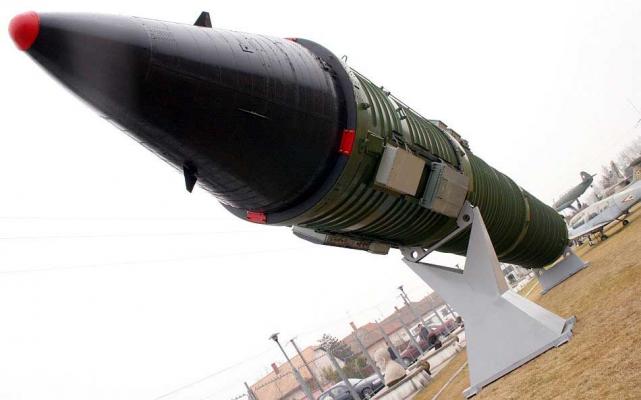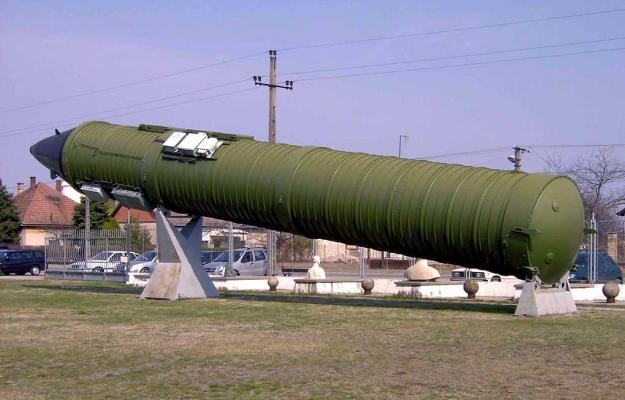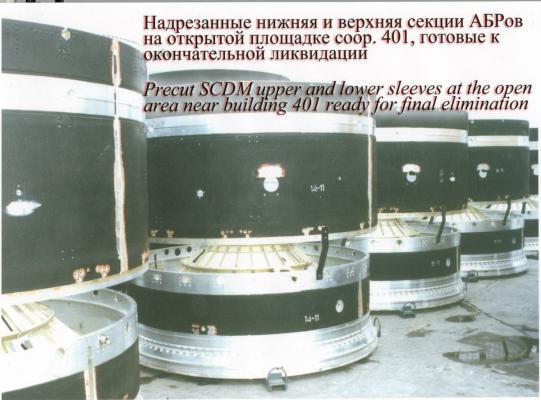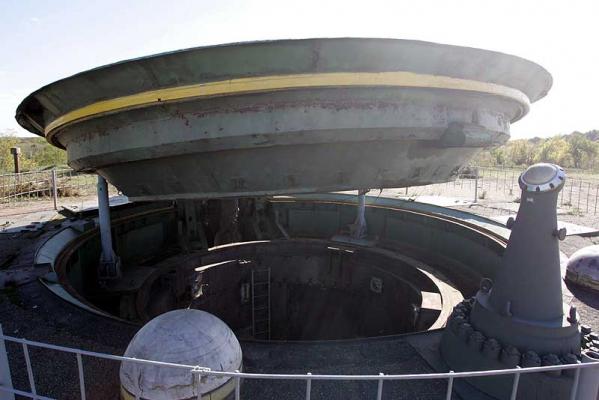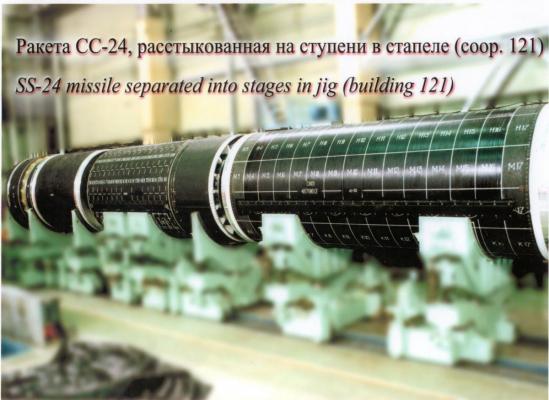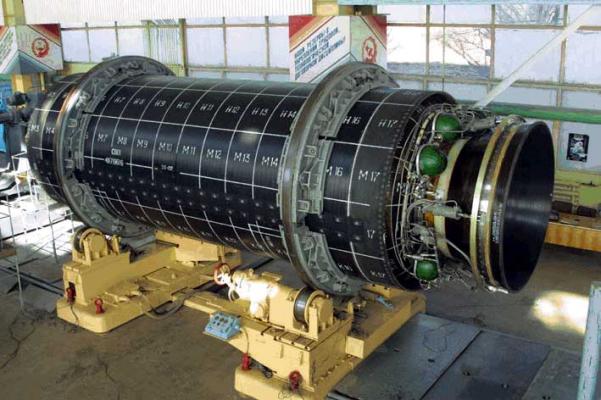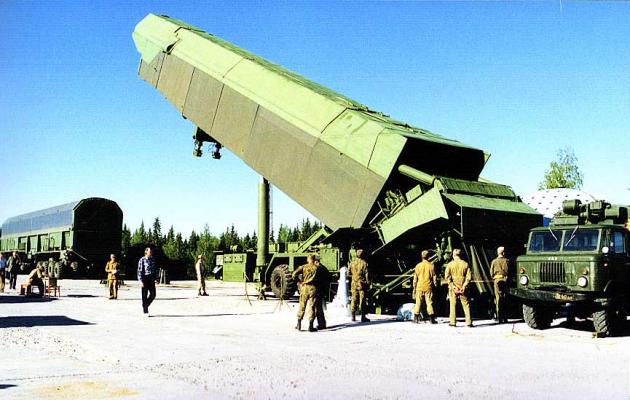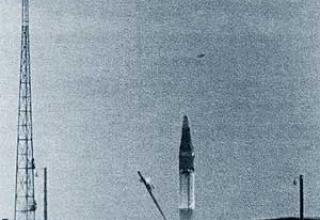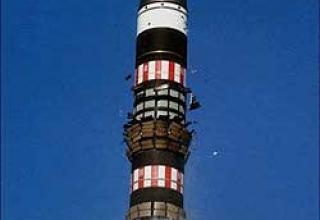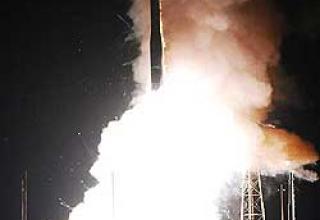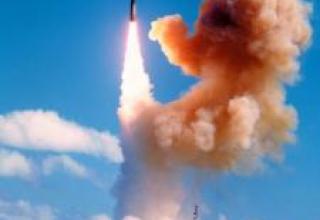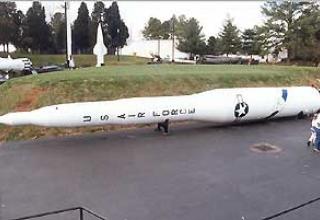By Resolution of the USSR Government No. 484-166 of June 23, 1976, Yuzhnoye DO was instructed to start full-scale development of the RT-23 silo-based stationary missile system with 15Zh44 lightweight ICBMs equipped with a monoblock HC, and also to begin work on 15Zh52 SLBMs developed on the basis of 15Zh44 missile. The establishment of RT-23 complexes was given very high priority by the country's leadership. On July 28, 1976 the Council of Chief Designers approved the main provisions for the development of the RT-23 rocket, according to which the following technical solutions were laid down in the rocket design: the first stage engine was unified to the maximum with the engine of the first stage of the 3M65 SLBM, the rocket design provided increased resistance to the effects of fossil fuels, flight control of the first and second stages of the rocket was provided by a system of "hot gas injection" into the critical part of the nozzle of the marching engines, and the third stage - by a cutter control system. Mass-size characteristics of the developed rocket were specified.
Although the developers understood that the accepted characteristics of the missile were stressful enough to perform, but the results of the first studies were unexpected - from the SSDO units and related organizations began to receive disappointing results Realizable launch weight of the missile significantly exceeded the target, required a very large number of bench tests. In the transitional areas of active flight when stages were separated, the missile's controllability was not ensured. Initially developed versions of the rocket flight control did not provide the necessary efficiency, led to a significant complication of the design, increase in dimensions and the launch weight. It was necessary to look for a new method of control. Shortly before that a group of enthusiasts in one of the departments of the SSDO had been researching a fundamentally new way to control the missile by turning the head compartment in a two-step cardan joint. Two components of the emerging control force were used: aerodynamic - in dense layers of the atmosphere and mass - throughout the flight section. Taking into account the stalled work on the missile controllability problem, the management turned to a new promising idea. On June 1, 1977 the Council of Chief Designers considered and approved the conceptual design of the complex with 15Zh44 missile, which approved the use of a new method of flight control on the missile - deviation of the head compartment. Many other original technical solutions were introduced into the design of 15Zh44 rocket - inflatable head fairing, mortar separation of steps, etc.
In the decision of the Council of the SC noted that the missile 15Zh44 on the declared characteristics of engines, fuels, main systems is fully consistent with the projected level of domestic rocket industry and superior in terms of technical characteristics of previously developed domestic models of solid fuel rockets, and the realized payload is approximately at the level of the rocket MX. At the same time, it was noted that the developed 15G44 missile is significantly inferior to the MX missile in a number of indicators that determine the combat efficiency of the complex (resistance to PFN, accuracy of firing, combat readiness). The reasons for the lag in terms of energy mass indicators were also mentioned: the use of a unified marching engine on the first stage of the missile, the low mass perfection of the missile's marching engines, and the reduced specific impulse values of the missile's engines. This, in fact, determined the direction of further work to improve the energy-mass performance of the rocket. By decision of the Board of Chief Designers of Yuzhnoye SDO as the lead designer was instructed to develop and send to the co-executing organizations for consideration and coordination of proposals to bring the level of perfection of the developed 15Zh44 missile to the level of MX rocket. In order to coordinate all activities related to the development of solid fuel in the Soviet rocket industry, by the decision of the MIC of March 28, 1979, an interagency coordination technical council was established, headed by Chief Designers V. P. Makeev, A. D. Nadiradze, V. F. Utkin.
Meanwhile, the development of the 15G44 missile continued at a steady pace. The peculiarity of this development was that due to its importance for the country, the tendency to ensure continuous introduction into the development of all the accumulated new technical solutions and to impose more and more new requirements to the characteristics of the developed missiles prevailed in the governing bodies, which inevitably led to the suspension of the work, returning to the already passed stages and, as a consequence, to the postponement of the deadlines for the implementation of the work. The government decree of June 1, 1979, in order to increase the combat efficiency of the RT-23 complex, the monoblock HC was replaced by a dividing head unit consisting of 8-10 combat units (BC) and anti-missile defense systems installed instead of the BC part. A new term for the start of flight tests was set - the first quarter of 1982. When developing an addition to the conceptual design of 15Zh44 missile in 1979-1980, a number of technical solutions were developed and implemented to improve the characteristics of the developed missile. One of the main was the use of a liquid propulsion system for distributing combat units. The results of the conceptual design of complexes with 15Zh44 missile showed that at the same level of development of domestic equipment and technologies it is not possible to meet the Customer's requirements in terms of ensuring the maximum firing range when installed on the missile 10 BB of a given power.
The first (partially successful) launch of the 15Zh44 missile took place on October 26, 1982 at the Plesetsk test site. The second launch, conducted on December 28, 1982, was fully successful. Of the eight launches, four were successful and four were emergency. Taking into account the fact that at that time the works on creation of more promising complexes on the basis of RT-23UTTH rocket had already started to unfold, the works on the stationary complex with 15Zh44 rocket were stopped (the decision of the Defense Council dated February 10, 1983).
In the late 70s - early 80s, the development of combat missile systems based on solid-propellant missiles evolved so that in parallel with the development of systems based on the RT-23 missile (15Zh44 and 15Zh52) Yuzhnoye DO and the co-executing organizations were tasked (government decree of June 1, 1979 ¹ 514-175) to begin the development of RT-23 missile with improved tactical and technical characteristics (RT-23UTTH) and systems based on it. The same decree determines the main developers of the complexes: Yuzhnoye DO - for the mine and railway complexes, MIT - for the ground complex. To launch the work on RT-23UTTH rocket, the Chief Designers' Council has agreed on the plan of work to ensure further improvement of RT-23UTTH rocket's TTH. Measures proposed at the Council to improve the performance of the RT-23 missile formed the basis for the decision of the MIC № 339, issued on December 27, 1979. The same decision determined the terms of development (release of the conceptual design - IV quarter 1982, beginning of flight tests - IV quarter 1984).
In April 1980, the Ministry of Defense issued a TTT to develop a missile for basing in three types of launch: mine, railroad and ground. Summarizing the results of the design and experimental works carried out in 1980-1982 to ensure the development of the RT-23 UTTH rocket, the Chief Designers Council (September 1982) noted that the full implementation of the requirements can be achieved only if the power of the RT-23 base rocket increases by ~30%, necessary to improve the basic characteristics of the developed rocket. However, the implementation of the relevant measures would require a large amount of testing and repetition in full of all stages of development of the engines and the missile as a whole. Ensuring the readiness for flight testing no later than in the fourth quarter of 1985 was only possible by successively increasing the level of required characteristics (primarily in terms of resistance to fossil fuels) while maintaining the already developed basic and structural layouts of the RT-23 missile and using new, more efficient fuels in the second and third stage engines, as well as improving the mass characteristics of booster, booster, engine housing and the missile as a whole. The conceptual design of the RT-23 UTTH rocket was released in November 1982. MIT, as the parent organization for the mobile ground complex with the RT-23 UTTH rocket, actively participated in its development.
The development of a thermonuclear charge for the combat equipment of the RT-23 and RT-23 UTTH RGCh ICBMs was also distinguished by its complex and contradictory nature, which was connected with the difficulties of work on the SSDM missile and with the strict requirements of the customer. In accordance with the directives of the MIC and the Ministry of Defense, which oblige the Ministry of Defense to develop combat equipment for the RT-23 ICBM, the VNIIEF developed a thermonuclear charge for this purpose, which was successfully tested in 1979. In January 1982, at the joint meeting of the scientific and technical leadership of the YSDO and VNIIEF it was decided to improve the layout parameters of the charge for RT-23 ICBMs and to reduce the weight of the ballistic missile by complex optimization of the charge, the ballistic missile body and the weight of the automatics while ensuring the required per-middle limit. VNIIEF developed and successfully tested in 1984 a charge with a narrow mid-range, which was later adopted for service in the missile system.
Government Resolution No. 768-247 on the creation of a missile system RT-23 UTTH with a single missile for three types of basing (mobile - railroad and ground, stationary - mine high protection) was issued August 9, 1983, and in November of the same year, a joint decision of the Ministry of Defense, the Ministry of Bashkortostan, the Ministry of Defense and the Ministry of Internal Affairs clarified the terms of creating a single missile. In April 1984, the Ministry of Defense issued to the developers of complexes based on the RT-23UTTH missiles specified TTT, which have already clearly defined that a single missile is developed taking into account individual structural and circuit differences due to the peculiarities of operation and combat use in mobile and stationary systems.
A strategy for developing complexes and missiles for them was adopted and proposed by the SSC:
- first of all, a missile for BZHRK 15Zh961 and a missile for the ground complex 15Zh62 should be developed taking into account the tight deadlines (beginning of serial production since 1986). The missiles use the main technical solutions tested on the 15Zh52 missile, and the missile structure's resistance to nuclear attack factors is ensured at the level optimal for mobile launches. By the decree of the Government of BZhRK with the missile 15Zh961 it was adopted for the Soviet Army in November 1989. By that time a considerable part of the group had already been put on combat duty in the position areas. As for the ground moving complex with 15Zh62 missile (Tselina-2) and 12-axle tractor MZKT-7906 being developed by MIT, its development was discontinued, as it became obvious that such a complex would not be able to provide the necessary characteristics in terms of combat efficiency;
- the stationary launch vehicle 15G60 is being developed on the basis of the beginning of serial production (since 1987), and should provide the upper level of characteristics of resistance to fossil fuels.
The development of the missile for the stationary complex 15Zh60 was carried out after the missile for the railway complex 15Zh961 and it started to be produced in the third quarter of 1984 by Yuzhnoye SDO and allied organizations in the third quarter of 1984. The development of additional design materials is a sketch project for the stationary mine complex with the missile developed in accordance with the requirements formulated by the Customer for the stationary complex of high survivability. At the end of 1984 the design materials were reviewed and approved by the Ministry of Bashchemash and the Customer. Since 1985, the cooperation headed by the REC has started to deploy a full-scale RCD for the 15P060 complex. In the course of design and development work, the technical appearance of a missile for silo-based basing was formed and went into further development - a light class solid-propellant ICBM with a launch weight of ~ 104.3 tons, delivering ten second level booster resistant to the designated targets, with an increased level of resistance to PFBI; a missile system that provides for the launch of the missile without delay for normalization of the external environment in case of multiple nuclear effects on neighboring ballistic missile facilities and in case of high-altitude nuclear blocking of the position area, as well as with a minimum delay in case of non-porous nuclear effects directly on the launch facility.
The high characteristics of the 15G60 missile in terms of providing an increased level of resistance to PFN were achieved at the expense of the missile:
- use of a newly developed protective coating applied to the outer surface of the missile body that provides comprehensive protection against PSNF;
- the use of SC developed on the element base with increased resistance and reliability;
- application of a special coating with a high content of rare earth elements to the case of the hermetic instrument compartment in which the XR equipment was located;
- application of shielding and special methods of laying the missile's onboard cable network;
- introduction of a special program manoeuvre of the missile when passing a cloud of ground-based nuclear material.
Flight tests of 15Zh60 missile were conducted at Plesetsk test site. Four launchers ("Yuzhnaya-1", "Yuzhnaya-2", "Svetlaya-1" and "Svetlaya-2") were built at the range for flight tests. The location of these launchers was chosen in such a way as to ensure the use of designated drop areas for the first stages when firing at any range. The Yuzhnaya-1 and Yuzhnaya-2 platforms were put into operation in 1986, Svetlaya-2 in 1987 and Svetlaya-1 in 1988. For missile launches, the Yuzhnaya-1, Yuzhnaya-2 and Svetlaya-2 platforms were used. No launches were made of the Svetlaya-1 PA, but it was used to test individual elements of the complex under special programs.
The first launch from Yuzhnaya-1 was successful on July 31, 1986. The launch of the 2L rocket was an emergency; the cause of the accident was a failure of the booster at the initial stage of motion. The launch of the 5L rocket - also an emergency because of the failure of the onboard XR. In order to eliminate the reasons for the failure of the booster, the developer carried out modifications, the effectiveness of which was fully confirmed by additional ground testing on the complex stand and subsequent launches. Start of 4L also became emergency - the insert of the nozzle block of the first stage engine unit was destroyed. As a result of thorough analysis, the cause of failure was identified and the nozzle block was reworked. The great work done by the organizations-developers has brought its positive results - there were no more emergency outcomes during the launches of missiles 15Zh60. The final launch under the test program was held September 26, 1988. Totally 16 missiles were launched during the state joint flight tests. Based on the results of the GSLI was released report of the State Commission with a recommendation to adopt the complex in service. The last launch of ICBM 15G60 - 8L missiles, which underwent transportation tests - was held November 1, 1989 in the area of "Aquatoria" with a positive result. It was included in the statistics as a set-off launch of a party missile conducted from the Svetlaya-2 launcher.
Since August 19, 1988, the first ICBMs were put on trial duty in the 46th Nizhnedniprovsk Red Banner Order of the October Revolution Missile Division (Pervomaysk, Nikolaev region, USSR). Deployment was rapid - by the end of the year there were already 20 missiles on duty. It may be considered an outstanding achievement that at the initial development level of 10 years or more, 15G60 ICBMs were put on combat duty with less than two years behind the American MX (LGM-118A) ICBM. In 1989, deployment continued in the first position area, and in the same year a new ICBM was launched in the second position area - the 60th Taman Red Banner Order of the October Revolution of the Missile Division named after the 60th Anniversary of the USSR (Tatishchevo, Saratov region, RSFSR). The new missile replaced the UR-100N UTTKh (15A35) ICBMs deployed in both areas. On November 28, 1989 the complex was adopted for service by the Soviet Army. By the end of 1989, 56 missiles (46 in the 46th Division and 10 in the 60th Division) had already been deployed in both position areas. However, starting from 1990, despite the fact that at least 8 missiles were manufactured in the PMP and prepared for deployment in the position areas, the deployment of ICBMs was stopped - the Soviet leadership adopted a new defense doctrine, which, along with the state program of conversion of the defense industry and the consultative and contractual process with the U.S., which imposed political and economic difficulties, made it undesirable to deploy in large numbers of new missiles even to replace the old ones.
In July 1991, the START-1 treaty was signed, and by November 1991, the process of the USSR's disintegration actually became irreversible. After the formal collapse of the Soviet Union in December 1991, production of new ICBMs at the PMZ was completely discontinued and the missiles deployed in Ukraine were to be de-alerted and destroyed under international treaties. In 1993-1994, all ICBMs in Ukraine were de-alerted and those removed from the missiles were then transported to the Russian Federation for disposal. In 1998-2001, the second stage was carried out: all 46 Ukrainian 15G60 ICBMs were removed from OS expandable ballistic missile systems. In 1999-2002, all ICBMs (including those that had never been placed on combat duty) were dismantled and disposed of (see Photo 1, Photo 2, Photo 3). The OS SLCMs were detonated except for one that served museum purposes.
The life cycle of ICBMs deployed in Russia was also short - it was decided to abandon the extension of the warranty period to 15 years (as in the case of ICBM 15G961 ) and by the end of 2001 all 10 ICBMs were taken out of the ICBMs and sent for disposal. The latest RT-2PM2 "Topol-M" (15J65) ICBMs were deployed in the OS ICBM after the upgrade with the designation 15P765-60. The "Visavi" 15J60 ICBM, the US MX ICBM, was also decommissioned in 2002-2005.
Evaluating the 15P160 ICBMs, it may be noted that for the first time in the domestic practice a fourth-generation high-efficiency stationary missile system with the latest solid-propellant ICBM equipped with a 10 BB RPMI has been developed to provide a guaranteed counter-response strike, including in the conditions of direct nuclear impact on the position area.
In the west, the 15G60 missile was designated SS-24 "Silrel" MoS 2. The name according to START-1 is RS-22B.
Composition:
15Zh60 missile (see diagram) of the marching stage and the stage of deployment of combat units. The head cowling was separated after passing the high-altitude AB blocking zone. The 15Zh60 missile retained the schematic and structural solutions used by 15Zh44 and 15Zh52 missiles to control the flight of the II and III stages of the head compartment deviation, mortar separation of stages, separation of the combat stage and dilution of combat equipment elements. Mortar separation of the stages was achieved by means of gas injection from the gunpowder pressure accumulator of the interstage volume and transverse fission of the connecting compartment by an elongated cumulative charge. This design guaranteed shockless stage separation and ensured the maximum density of the layout of the interstage part of the missile.
The rocket propulsion systems (RPS) were developed mainly within the framework of cooperation established at the stage of development of complexes with missiles 15Zh44 and 15Zh52. The 15Zh60 (second level of resistance) missile RTBMs (second level of resistance) have been designed to meet increased requirements for power, control forces (15D305, RU-I) and protection against PSNF (15D339, RU-II; 15D291, RU-III). For the 15J60 and 15J961 ICBM engines, third and fourth generation fuels were developed on the basis of the new chlorine-free oxidizer ADNA. The complex of fundamental works on creation and introduction of ADNA as one of power-consuming and ecologically pure oxidizers, carried out in cooperation with institutes of the Academy of Sciences, higher school and branch institutes, was a large domestic scientific and technical achievement, more than 20 years ahead of the world level in the field of rocket fuel energy. For the first time in the fuel formulation of these rockets, a fundamentally new highly efficient fuel, aluminium hydride, was used.
In the course of works on creation of RDTT MBR 15Zh60 and 15Zh961, new structural, heat-proof and erosion-resistant materials were developed, including high-strength organic and high-modulus carbon fibers, carbon compositions with 2D and 3D oriented matrix, high-strength heat-resistant adhesives, manufacturing technology and methods of non-destructive quality control were worked out, new fuels with unique energy and performance characteristics and optimal charge forms based on them were created. For the first time in domestic practice, remote control cases made of CBM organ material with high specific strength were developed, which contributed to improvement of rockets' energy and mass perfection.
This made it possible to create and implement them for use:
- motor cases made of organoplastic cocoon design;
- critical section parts and nozzle block sockets made of carbon-carbon materials;
- large multi-block insert made of three-dimensional reinforced carbon-carbon material;
- carbon-carbon material nozzle caps;
- swivel control nozzle based on elastic joint;
- tail section made of structural carbon plastic.
The first stage consisted of a RDTT 15D305 march, tail and connecting compartments. In the conceptually new engine of the first stage of SDO development and PMZ production there was applied a higher energy (as compared to MBR 15Zh961) blended solid fuel of "OPAL" type - the developer of LNPO "Soyuz". The solid fuel charge had a star-shaped channel and was firmly bound to the engine body. Consumption and traction characteristics were boosted by 30% in comparison with the engine 15D206 of the first stage of the rocket 15Zh961, which resulted in an increase in pressure in the combustion chamber up to 100 kgf/cm2, as well as used as a control device for the traction vector central, partly recessed in the combustion chamber, multi-position (circular diagram of the creation of control force Rupr. through the channels of pitch and yaw) oscillating control nozzle with a connector in the subsonic part, made of composite carbon-carbon materials, using as a suspension of the swivel part of the elastic support joint. Step body is an all-wound organoplastic type "cocoon", made by winding method of threads from composite material, chosen according to the then state of domestic production base. In view of maintenance of the minimum weight of a design the following variant is chosen: at the heart of a bundle of threads from a composite material and special binding substance. On the second and third marching steps the same variant of manufacturing of the case is applied. For heel control on a site of work of remote control-I 4 aerodynamic steering wheels established on an external surface of a head cowl were used. Besides, at the end of a site of work of the first marching stage stage control of a stage was carried out and a deviation of a head part of a rocket.
The engines of the second and third stages were equipped with each central partially recessed into the combustion chamber stationary nozzle with a telescopic sliding socket nozzle made of carbon-carbon material, which allowed to increase the degree of expansion of the nozzle and, accordingly, specific impulse, without increasing the overall dimensions of the missile.
The second stage consisted of a RDTT 15D339 march and a connecting compartment. The body of the second stage is an all-wound organoplastic type "cocoon". Fuel of the second stage - solid mix type "START" (developer LNPO "Soyuz"). Solid fuel charge - firmly fastened to the engine body, with a cylindrical conical channel with an inclined ring flow of "umbrella" type. Special multifunctional coating has been additionally applied on the case of DU-II developed by the Design Bureau and manufactured by PMZ of 15Zh60 missile (in comparison with 15Zh961). The second stage was controlled by the head part deviation and aerodynamic rudders (roll) mounted on the nose fairing.
The third stage consisted of a RDTT 15D291 march and a transitional compartment (see photo). DU-III of 15Zh60 and 15Zh961 missiles developed by the Iskra Design Bureau and produced by the Perm Chemical Equipment Plant were almost identical (AP-65 type solid propellant, developed by LNPO Soyuz). A special multifunctional coating has been additionally applied to the MA-III body of missile 15Zh60 (as compared to MA-III of missile 15Zh961). The hull of the third stage is an all-wound organoplastic type "cocoon". The third stage was controlled by deflection of the head end and tilted stage RDTs.
For the missile 15G60 was developed a new combat unit enhanced resistance to 15F14 PFC with high specific power and has characteristics similar to the Mk21 missile "MX". The main part is a dividing type of individual guidance with ten thermonuclear drones with a capacity of 0.43 Mt and a set of means to overcome the ABM development of the RSD. Originally KSP PRO was made on PO "Yuzhmash", however since May, 1986 manufacture has been transferred on adjacent enterprises of RSFSR.
The stage of deployment of combat units - "pushing" circuit, placement of combat units in one tier, the stage engine - ZHRD RD-866 (15D264), created in the SSDO-4 and produced at Yuzhmash, working on liquid highly boiling stable long-stable self-extinguishing fuel components: asymmetric dimethylhydrazine (NDMG) and nitrogen tetraoxide (AT). RD-866 engine - multifunctional, without generator gas afterburning, with multiple switching on BT (high thrust) and MT (low thrust), provided multiple starting and traction control. The engine worked according to the combined scheme (displacement and pump feeding of fuel components). It provided a wide range of cost and pressure changes for consumer mechanisms. RD-866 contained: centralized power supply (consisting of two turbo-pump units with gas generators and two feeders); single-chamber LRD BT; 16 LRD MT.
For three-stage solid fuel missile 15G60 from the stage of dilution was required not only to ensure the construction of combat orders from the booster and means to overcome the missile defenses, but also to use to achieve the maximum range set by the mode of "effective overclocking" - to ensure the operation of the dilution stage in the active section of the trajectory as a fourth stage of the missile, which provided a significant gain in payload weight (up to 15%). To reduce the missile's length, a variable geometry aerodynamic head fairing was used to cover the MS, the two flaps of which were closed after the missile left the TIC.
The structure of the missile was protected by a special external multifunctional coating along the entire length of the missile (including the head fairing) to protect it from projectile impacts.
A very important point in the process of development of 15J961 and 15J60 missiles with the required level of basic characteristics was the development of control systems for them, to which the Customer set very strict requirements in terms of the level of basic flight characteristics - alert status, hit accuracy, resistance to the effects of PFN in the conditions of multiple effects on the position area and its high-altitude blocking by nuclear explosions, increased resource of continuous operation of on-board equipment. Fulfillment of these requirements demanded from the developers of the SU the creation of command gyroscopic devices with improved accuracy characteristics, the new Beader-3 BCVK of increased productivity and resistant to the impact of destructive factors of nuclear weapons, providing aiming through the implementation of autonomous determination of the azimuth of the control element, mounted on a gyrostabilized platform, using a ground set of command devices, placed on the TPK. As part of a special program for the control system there was developed a radiation-resistant element base and large integrated circuits for BCVC.
The creation of special radiation-resistant electronics for ICBMs in the USSR was a complex process that began as early as the 60s - the decision № 149 of the Military Industrial Commission on the resistance of electro-radioelectric elements to nuclear explosion was adopted in 1968. Later on, hard work in this direction was not ceased - for example, only during 1977-1979 a special program of 6 nuclear test sites was conducted, which allowed to obtain valuable data on the radiation resistance of electronic components of the systems of the main Soviet ICBMs; allowed to study the impact of hard gamma-radiation and neutron fluxes on the hulls, combat units and electronics of Soviet ICBMs, including promising ones; provided an opportunity to study the effects of powerful electromagnetic pulses. The results of long-term tests and theoretical studies have led to a conclusion that the weakest link in the design of ICBMs under the influence of PFBI are actually electronic systems, whose resistance to nuclear blast threats was found unsatisfactory in the prospect of the emergence of new high-precision delivery vehicles for nuclear warheads and new-generation nuclear warheads in the likely adversaries (primarily, the United States) in the 1980s. As a result, in 1982 the MIC issued a special resolution on the creation of PFN-resistant electronic elements - from super-large integrated circuits to transistors and capacitors. More than 600 organizations - research institutes, design offices and universities - were involved in the work. In 1985 at one of the meetings of the military-industrial complex it was stated that the electronic equipment products resistant to the action of PSNF were created in the USSR.
The control system of the second level of durability was developed by NPO "Khartron" (chief designer V.G. Sergeev, then Ya.E. Eisenberg). Schematic-algorithmic protection of the control system equipment from gamma radiation at nuclear power was introduced in the SU. Yuzhnoye" Design Office in cooperation with CNIImash, Institute of Technical Mechanics of the Academy of Sciences of the Ukrainian SSR, Dnepropetrovsk State University developed a dynamic scheme of the system with variable masses and configurations (including jump-shaped changes), taking into account the elasticity of the body and cardan assembly, which was the basis for the development of the control system. The new method of control - head deviation - concealed great potential, which was fully realized. This method did not require the rocket's energy costs due to the loss of thrust of the marching engine when creating the actual control forces. Thanks to this, the perturbations in the roll channel were minimal, which gave a real opportunity to simplify the control circuit and the controls.
The peculiarity of the SC was the solution of a number of new tasks:
- recovery of information in the calculator after exposure to PSNRs by overwriting it into an operative memory from the information storage on the magnetic disk;
- implementation of terminal guidance principles;
- use of the element base of increased resistance to fossil fuels (for 15J961 - level I, for 15J60 - level II);
- combat duty of 15Zh60 missiles with permanently activated command devices;
- interface with the "Signal-A" SBU system.
The 15P160 combat missile system with 15Zh60 ICBMs included 10 OS 15P760 ICBMs and the 15B52U unified mine command post created by the Central Design Bureau of Machine Building (see Photo 1, photo 2, photo 3). Launching unit 15П760 - mine, single launch, highly automated, with high protection against fossil fuels. The modified launch complex could reliably withstand an excess pressure in the front of a nuclear explosion shock wave of at least 100 atmospheres. The PU 15P760 was designed with a maximum borrowing of a protective device, a construction structure previously developed for the 15A35 ICBM at the Vympel State Research and Production Institute. (SHU OS 15P735) (Chief Designers V.M. Baryshev, O.S. Baskakov). The missile was placed in a transport and launch container (TLC) and launched by the mortar launch method. Detonating elongated charges were used to separate the missile from the transport and launch container and the pallet. The TPC was equipped with a temperature control system and automatic missile launch. The development and testing of the missile's support elements in the TIC was carried out by the Design Bureau in cooperation with the Dnipropetrovsk Institute of Elastomeric Materials Technology (DINTEM).
At PU 15P760 systems and units have been introduced to ensure constant readiness and autonomy during the entire period specified by the TTT. The combat application was provided in any weather conditions at air temperature from -50 to +50 °С, before and in conditions of nuclear impact on the ballast. The levels of the missile's resistance to PFN, which were implemented to ensure a countermeasure launch, ensure its successful launch after the non-porous nuclear material directly on the booster and without reducing the combat readiness under the influence of the adjacent booster. The initial warranty period of the missile is 10 years.
Characteristics:
| Range of fire, km | 10450 |
| Circular probable deviation, m. | 220 |
| Generalized reliability indicator | 0.94 |
| Header | |
| - charge power, Mt | 10 х 0.43 |
| - head weight, kg | 4050 |
| The length of the rocket, m | |
| - in flight | 23.0 |
| - headless | 19.0 |
| - at the TIC | 21.9 |
| Maximum rocket body diameter, m | 2.4 |
| Start weight, t | 104.80 |
| First step - kerb weight, t - overall length, m - overall diameter, m - remote control thrust (on the ground/in the void), tc |
53.7 8.4 2.4 280/310 |
| Second step - kerb weight, t - overall length with a folded socket, m - overall length when the socket is extended, m - overall diameter, m - remote control thrust, shh. |
25 5.9 6.7 2.4 150 |
| Third step - kerb weight, t - overall length with a folded socket, m - overall diameter, m - remote control thrust, shh. |
15 3.6 2.4 44 |
| Liquid rocket engine RD-866 (combat stage) | |
| Engine traction in the void, kgs. | between -94.4 and +513.5 |
| Specific median-integral pulling impulse of high traction WRD in the void, kgc/kg | 305.5 |
| Specific traction pulse in the void, kgc/kg - heavy-duty LCD cameras - Low traction WRD in continuous operation - Low thrust LPD in pulse mode with frequency 10 Hz |
323.1 245 176 |
| Engine weight, kg | 125.4 |
| Absolute gas pressure in the combustion chamber, kgf/cm2: - High draught LPG - low draft LCD |
41.5 5.67 |
| Absolute gas pressure at the chamber nozzle cut, kgf/cm2: - High thrust WRD - low draft LCD |
0.024 0.007 |
| Mass average integrated ratio of fuel components at work: - High thrust WDF - heavy-duty LCD cameras - low draft LCD |
2.03 2.3 1.85 |
| Traction deviation from the nominal value, kgf - for heavy-duty WRD - for low-draught LCDs when working in continuous mode |
±41 ±0,65 |
| Minimum absolute pressure of fuel components at engine inlet, kgf/cm2: - oxidant (at 45°C) - combustible (at 65°C) |
6.0 3.5 |
| Minimum absolute pressure of fuel components at engine inlet at +35°C, kgf/cm2: - oxidizer - fuel |
4.5 1.45 |
| Maximum total operating time, s: - High Traction WRD - low draft LCD |
330 1200 |
| Maximum number of turns on: - High-pulse LPD - low draft LCD |
14 10000 |
Testing:
On the basis of missile 15A35 in the Khrunichev State Research and Production Space Center was created a conversion rocket lightweight class "Rokot" (see photo), its launches are conducted from the State Test Cosmodrome Plesetsk. The Rokot LV is a three-stage rocket. The first and second stages are the UR-100N ICBM missile block. The Breeze upper stage is used as the third stage. The length of the missile - 27.7 meters, diameter - 2.5 meters. The launch weight (without payload) is 107 tonnes. The launch vehicle is capable of launching a payload of 1950 kg into orbit with a height of 200 km or 1250 kg into orbit with a height of 1500 km. Relative weight of the payload is 1.82 %.
On the basis of 15A35 rockets in NPO Mashinostroyenie there is a space rocket system "Arrow" (see photo), designed to launch spacecraft from Svobodny cosmodrome from the upgraded 15P720 silo launcher, designed to launch 15A20 rockets. The main concept implemented in this project is to preserve the maximum continuity of the Arrow Space Station with the base complex. The use of the Arrow Space Missile System will provide economically viable launches of small spacecraft into orbits with different altitudes and inclinations. The 15A20 missile is smaller in size and energy than the 15A35 missile. For this purpose, the 15P720 mine is deepened and reinforced at its lower part. The geometry of the upper part of the SHPU is changed as well, similar to the upper part of the 15P735 SHPU for installation of the gas exhausting grating.
Sources:
- "Призваны временем. Ракеты и космические аппараты конструкторского бюро "Южное"./ Под общей редакцией С.Н.Конюхова/. Д.: Арт-Пресс, 2004,-232с.
- Карпенко А.В., Уткин А.Ф., Попов А.Д. "Отечественные стратегические ракетные комплексы", -СПб.: Невский бастион-Гангут, 1999.-288с.
- "КБ специального машиностроения: От артиллерийских систем до стартовых комплексов" (под редакцией Ушакова В.С.) .СПб, 2004.
- Андрюшин И.А., Чернышев А.К., Юдин Ю.А. "Укрощение ядра. Страницы истории ядерного оружия и ядерной инфраструктуры СССР" / С., С.: Красный Октябрь, 2003.
- Pavel Podvig, "The Window of Vulnerability That Wasn't: Soviet Military Buildup in the 1970s--A Research Note", International Security, Summer 2008, Vol. 33, No. 1: 118-138
- М.Первов. "Межконтинентальные баллистические ракеты СССР и России". Краткий исторический очерк. / М.: 1998.
- www.fas.org
- www.astronautix.com
- www.iskra.perm.ru
- www.oborona.ru
- Жидкостный ракетный двигатель РД-866
- http://archives.gov/
